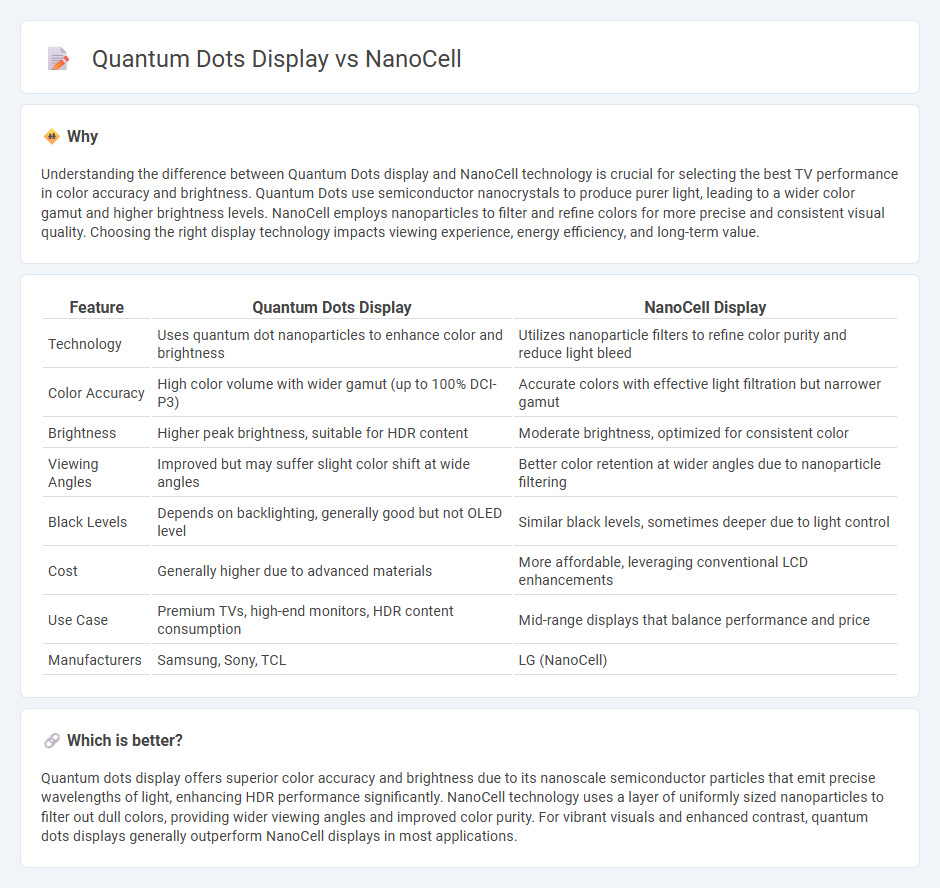
Quantum dots display technology utilizes semiconductor nanocrystals to produce vibrant colors with high brightness and energy efficiency, enhancing screen clarity and contrast. NanoCell technology employs a layer of uniform nanoparticles to filter out dull colors, delivering more accurate color reproduction and wider viewing angles on LCD screens. Discover the distinct advantages of both technologies for next-generation display experiences.
Why it is important
Understanding the difference between Quantum Dots display and NanoCell technology is crucial for selecting the best TV performance in color accuracy and brightness. Quantum Dots use semiconductor nanocrystals to produce purer light, leading to a wider color gamut and higher brightness levels. NanoCell employs nanoparticles to filter and refine colors for more precise and consistent visual quality. Choosing the right display technology impacts viewing experience, energy efficiency, and long-term value.
Comparison Table
| Feature | Quantum Dots Display | NanoCell Display |
|---|---|---|
| Technology | Uses quantum dot nanoparticles to enhance color and brightness | Utilizes nanoparticle filters to refine color purity and reduce light bleed |
| Color Accuracy | High color volume with wider gamut (up to 100% DCI-P3) | Accurate colors with effective light filtration but narrower gamut |
| Brightness | Higher peak brightness, suitable for HDR content | Moderate brightness, optimized for consistent color |
| Viewing Angles | Improved but may suffer slight color shift at wide angles | Better color retention at wider angles due to nanoparticle filtering |
| Black Levels | Depends on backlighting, generally good but not OLED level | Similar black levels, sometimes deeper due to light control |
| Cost | Generally higher due to advanced materials | More affordable, leveraging conventional LCD enhancements |
| Use Case | Premium TVs, high-end monitors, HDR content consumption | Mid-range displays that balance performance and price |
| Manufacturers | Samsung, Sony, TCL | LG (NanoCell) |
Which is better?
Quantum dots display offers superior color accuracy and brightness due to its nanoscale semiconductor particles that emit precise wavelengths of light, enhancing HDR performance significantly. NanoCell technology uses a layer of uniformly sized nanoparticles to filter out dull colors, providing wider viewing angles and improved color purity. For vibrant visuals and enhanced contrast, quantum dots displays generally outperform NanoCell displays in most applications.
Connection
Quantum dots displays and NanoCell technology are connected through their reliance on advanced nanomaterials to enhance visual performance. Quantum dots utilize semiconductor nanocrystals to produce precise colors with high brightness and efficiency, while NanoCell employs a layer of uniformly sized nanoparticles to filter and purify colors, improving color accuracy and viewing angles. Both technologies aim to deliver superior image quality by manipulating light at the nanoscale for vibrant, true-to-life visuals.
Key Terms
Color Accuracy
NanoCell displays utilize a layer of nanoparticles to absorb unwanted light wavelengths, enhancing color purity and delivering precise color accuracy with vivid, true-to-life images. Quantum dot displays employ semiconductor nanocrystals that emit specific light wavelengths when illuminated, resulting in wider color gamuts and exceptionally bright, accurate colors across a broader spectrum. Explore detailed comparisons of NanoCell and Quantum Dot technologies to discover which display best suits your visual needs.
Backlighting Technology
NanoCell displays utilize a layer of nanoparticles to absorb unwanted light wavelengths, enhancing color purity and brightness with an LED backlight system. Quantum dot displays feature semiconductor nanocrystals that emit precise colors when illuminated by blue LED backlighting, delivering a wider color gamut and higher peak brightness. Explore more to understand how backlighting technologies impact visual performance and viewing experience.
Viewing Angles
NanoCell displays utilize a layer of nanoparticles to absorb unwanted light wavelengths, resulting in enhanced color accuracy and wider viewing angles compared to traditional LCDs. Quantum dot displays incorporate semiconductor nanocrystals that emit pure light, offering superior brightness and color volume, but can exhibit narrower viewing angles due to the directional nature of emitted light. Explore the detailed differences and benefits of each technology to choose the best display for your needs.
Source and External Links
Nanocell Therapeutics - Transforming cell & gene therapy - NanoCell Therapeutics develops non-viral, DNA-based in vivo gene therapies that modify target cells directly within the patient's body, aiming to transform adoptive cell therapies into scalable, affordable, and safe gene therapies for diseases such as B cell malignancies.
What is NanoCell? Is a NanoCell TV Worth It? | Rent-A-Center - LG's NanoCell technology represents a type of TV display that enhances color accuracy and clarity by using particles that absorb unwanted light wavelengths, resulting in a richer spectrum of over one billion colors and better picture quality at wide viewing angles.
What is a NanoCell TV? LGs Latest Technology Explained - LG NanoCell TVs include a special NanoCell layer that prevents excess light and color bleeding from the LED backlight, improving contrast and image sharpness, while delivering wider viewing angles and affordability compared to OLED or QLED TVs.
 dowidth.com
dowidth.com